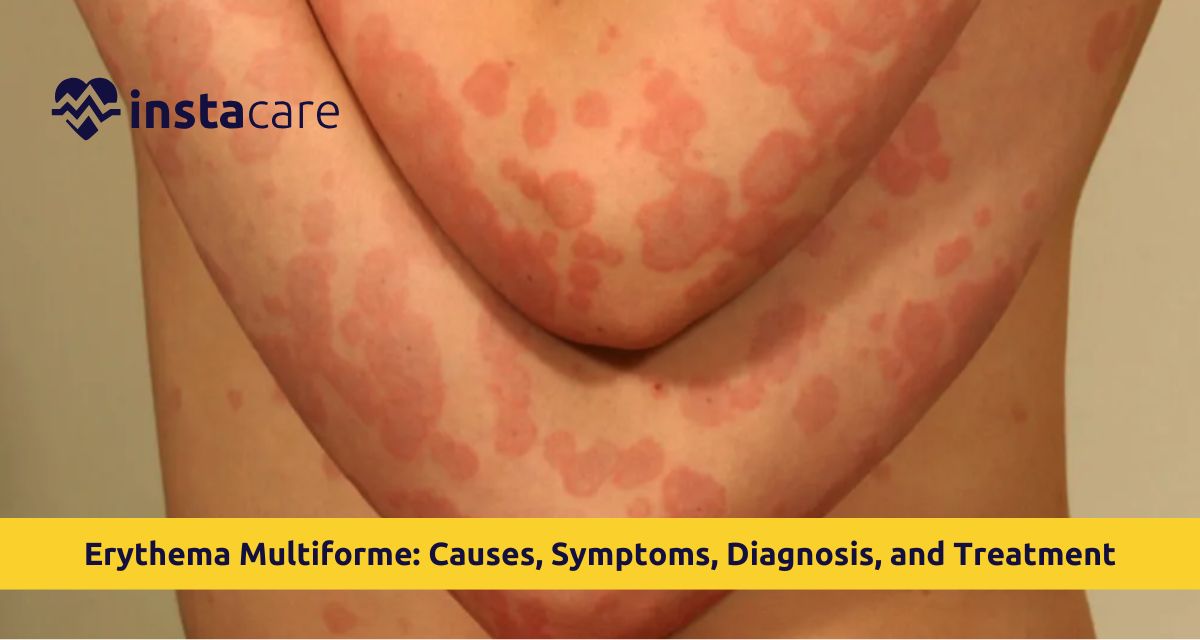The condition gets its name in this way because it produces all sorts of rashes and spots on the skin. They erupt suddenly and even look frightening, but are normally harmless and heal well with proper care. As long as individuals are knowledgeable about the signs, causes, and treatments, they can manage fairly well with the condition.
What is Erythema Multiforme?
Erythema multiforme is a hypersensitive response of the skin that evokes target-like lesions and other cutaneous changes. The disease occurs when the immune system overreacts to something, thereby causing a skin complication. It has two forms: erythema multiforme minor and erythema multiforme major.
Milder erythema multiforme minor is the one that occurs in the skin predominantly. It produces rounded target-spots on the hands and feet, and in some other body parts. It is more prevalent and usually not problematic.
Severe erythema multiforme major involves the skin, oral cavity, eyes, and genitalia. More severe erythema multiforme can be treated more aggressively first and then followed up by a doctor. Major type hurts more and takes longer to heal.
The erythema multiforme rash is usually rounded lesions that are color rings in mixed color. The rash is at times said to resemble the bull's eye or target. The lesions are red, pink, or purple and at times they have blisters in the middle at times.
Causes of Erythema Multiforme
The erythema multiforme causes is infection, drugs, and other offenders that initiate the immune system to over-act. Knowing the causes prevents individuals from not gaining causes and getting treated if needed.
Infections are the most frequent cause of this illness. Erythema multiforme causes herpes infections that result in erythema multiforme infections due to infections are very frequent, and
herpes simplex virus is the cause in most of these. Fungal infection, bacterial infection, and certain viral infections are some infections which result in the illness.
Erythema multiforme medication reaction is when the skin condition is caused by a specific drug. Such types of drugs that cause the condition include antibiotics such as sulfonamides and penicillin, analgesics, anticonvulsants, and other drugs. The doctors ask the patients to inform them of any drugs that they use in case they experience any skin condition.
Causes can also be:
- Autoimmune diseases where the immune system of the body attacks the body
- Some tumors or cancers
- Cancer radiation therapy
- Pregnancy in certain unusual conditions
- Unknown cause in which no identifiable reason can be determined
Some of them are such that doctors are not able to ascertain the cause of the condition, and then it is referred to as idiopathic erythema multiforme. It happens in about half of all cases, so symptom management is a significant area to address greater than attempting to establish the cause.
Symptoms of Erythema Multiforme
The erythema multiforme symptoms also differ based on whether an individual has the minor or major type of the disease. Identification of such symptoms helps an individual get suitable medical attention at the appropriate time and know what to expect during the process.
The most frequent sign is the characteristic rash on the body. The rash starts first on hands and feet, and subsequently in the rest of the body. The lesions are usually target-shaped rings of opposite color - center dark, middle light ring, and outer darker ring.
Signs and symptoms are:
- Target spots on the skin, particularly on hands and feet
- Red, pink, or purple round patches
- Blisters located in the center of lesions
- Burning and itching of affected skin
- Malaise and low fever
- Fatigue and ache
Other erythema multiforme symptoms that are commonly linked to erythema multiforme major are:
- Sore mouth resulting in pain and discomfort when eating
- Eye involvement with pain, redness, or change in vision
- Genital tenderness
- More systemic with more fever
- Difficulty in respiration when speaking or swallowing with sore mouth
The rash will usually develop a few days later and can still recur for up to two weeks. Erythema multiforme pictures on medical websites can also make one able to identify what the rash usually looks like, but seeing a doctor is always advisable for accurate diagnosis.
Diagnosis of Erythema Multiforme
Erythema multiforme diagnosis is most often made by a physician examining the skin and questioning the patient regarding recent illness, medications, and symptoms. Target-shaped rash of the disease simplifies diagnosis, but physicians occasionally must have other tests done in order to identify the condition and rule out other dermatologic diseases.
Physicians will examine the site, distribution, and character of the rash for a diagnosis. Physicians will question regarding recent illnesses, recent medications, and history of skin disease in the family. The time interval when the rash and other symptoms begin to enable physicians to interpret the degree and pattern of erythema multiforme.
Physicians require other tests like in certain instances:
- Skin biopsy of a sample of involved skin on a microscope
- Blood screening to exclude infection or other condition which predisposes to condition
- Herpes virus screening if herpes infection is under consideration
- Allergy screening if drug reactions are under consideration
Erythema multiforme vs stevens johnson syndrome is another significant differentiation that must be made by doctors. Stevens-Johnson syndrome is a more serious illness which can be life-threatening, whereas erythema multiforme is usually less severe. The key differences are the extent of the skin manifestation, whether or not it blisters, and how severe the symptoms overall are.
Early and accurate diagnosis secures adequate care and follow-up, particularly for the more serious form of the disease that might require broader treatment.
Treatment Options of Erythema Multiforme
Erythema multiforme treatment is aimed at the relief of symptoms, the treatment of any precipitating cause, and the prevention of complication. Treatment is based on whether a person has the minor or the major variant and the causative factor of the disease.
Erythema multiforme management of minor erythema multiforme can include:
- Cool, moist cloths to the affected area to relieve pain
- Over-the-counter tablets such as ibuprofen or acetaminophen
- Antihistamines to alleviate itching
- Topical cream or ointment to calm the skin
- Rest and proper hydration
Severe cases may involve:
- Prescription corticosteroid drugs to alleviate inflammation
- Aggressive pain medication to alleviate pain
- Antiviral drugs if caused by herpes
- Antibiotics if bacterial infection was the culprit
- Complication monitoring
Erythema multiforme treatment of erythema multiforme major usually involves:
- Hospitalization in serious cases
- Intravenous hydration when eating and drinking is difficult
- Special oral care for blisters in the mouth
- Eye care if symptoms occur in the eyes
- Skin lesion wound care
The erythema multiforme prognosis is generally excellent, particularly for the minor form. Most patients have a complete recovery within 2-6 weeks without complications. The major type heals slowly and must be watched more closely, but most patients again have an uneventful recovery with adequate therapy.
Prevention of Erythema Multiforme
Prevention of erythema multiforme is avoidance of known precipitants where possible, and treatment of underlying disease which predisposes to it. Although all cases cannot be prevented, some will avoid the development of the condition.Erythema multiforme recurrence can occur in some people, most particularly those infected with herpes. People who develop recurrent attacks will be helped by:
- Prevention of herpes attacks by antiviral drugs
- Prevention of known drug precipitants
- Management of precipitating stresses which initiate attacks of herpes
- Prevention of general well-being and immune response
Erythema multiforme in children demands special attention in prevention since children cannot verbalise the symptoms effectively. Parents must be watchful for unusual rashes and get the patient to the doctor as soon as possible if target-shaped lesions are noticed.
Prevention interventions are usually:
- Notification of healthcare workers about the history of drug reaction
- Treatment of first infection, especially herpes
- Avoidance of noted precipitating factors once established
- Individuation of proper hygiene to avoid infection
- Follow-up with physicians as indicated for continuing care
Erythema multiforme patients need to watch for possible precipitants and alert all of their health care providers to that effect in an attempt to avoid recurrence.
Conclusion
Erythema multiforme is a severe-looking but curable illness which exists in the skin. In most cases, the condition can be treated successfully by the adequate medical treatment. With the knowledge of symptoms, causes, and treatment process, one is well prepared regarding what to do if he/she develops the condition. Although the rash in the form of a target is the matter of concern, most of the patients recover fully after they are treated with the appropriate regimen.
Early intervention and proper medical evaluation are needed to be provided with the proper care and prevent complications. Unexplained rashes on the body, particularly target-shaped rashes on the hands or feet, ought to consult a health professional for evaluation and advice on management.
The disease is a testament to the ability of the immune system to respond to different stimuli, and to the value of control of primary medical diseases and watchfulness for drug sensitivities. Familiarity with sufficient knowledge and proper medical treatment will ensure the patients with erythema multiforme good prognosis and complete remission.
Please book an appointment with the
best Dermatologist in Lahore, Karachi, Islamabad, and all major cities of Pakistan through
InstaCare, or call our helpline at 03171777509 to find the verified doctor for your disease.

